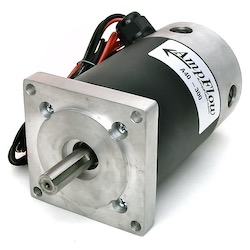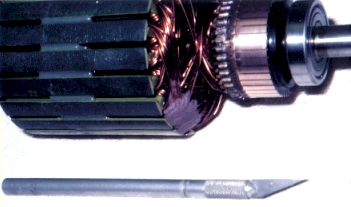
AmpFlow high-performance motors are designed to give the highest level of performance possible in a brushed DC motor. This is achieved by advanced multi-pole design and the use of neodymium rare-earth magnet materials.
The horsepower and torque of our high-performance motors are higher than other reversible, permanent magnet motors in this size range. Some gearmotors can't even achieve these high torque levels - even after multiplying the torque with a gearbox.
Usually, the higher the voltage and RPM of a motor, the higher its efficiency will be. Some motors have high efficiency, but only at very high speeds. Gearing such high RPM down to a usable speed takes several stages of gear reduction. This is expensive, and the efficiency advantage usually disappears. The trick is making a moderate-speed motor that is also highly efficient. The relatively low RPM of our motors makes any required speed reduction much easier. AmpFlow motors are available with several speed reducer choices.
Solid Construction - Easy Mounting
These motors are made from two sturdy aluminum castings and a seamless body. The long output shaft makes it easy to mount pulleys, sprockets, and gears. A second 3/8" diameter shaft extends 1/2" from the rear of most models. This is very handy for mounting encoders, fans, tachometers, brakes, or other devices.
Some motors use an internal fan to reduce overheating. Our high-performance motors are efficient enough to operate without a fan. This has three advantages:
- The motor housing is completely sealed so nothing can enter the motor and damage it;
- The sealed motor tends to contain radio-frequency noise that would otherwise radiate through the ventilation holes;
- Increased efficiency because the energy that would normally be used to run the fan generates mechanical power instead.

The A40-300 being tested on the dynamometer.
The armatures in our high-performance motors ride in two large high-quality ball bearings, and they're dynamically balanced using epoxy rather than by the usual method of drilling the laminations. Drilling can cause eddy currents in the laminations, which increase motor heating.
Each of the four brushes has its own heavy-duty motor lead made from mil-spec flexible stranded wire. Each copper strand is coated with pure silver to protect against oxidation and get the lowest possible resistance in crimped connections. These leads are flexible but not "floppy," so they tend to stay where you put them. The four leads have high-temperature Teflon insulation rated for 200C (392F).
Efficiency
Getting high efficiency from a low-voltage motor is not easy. Many factors affect efficiency. We have optimized each of these factors to achieve very high efficiency in these motors.
The armatures are wound with heavy gauge wire, and all the space in the armature is used. We left no power-robbing "empty air" in the slots. The smaller motors have skewed armature laminations to eliminate the heavy "cogging" that results from using the extremely powerful neodymium magnets. The A40 motor uses straight laminations, but the cogging is kept very low by using a 42-bar commutator. The huge 1.75" diameter of the commutator combined with the four massive brushes and the 42 bars enabled us to get high power and high efficiency from this smooth-running motor (the A28 and F30 motors have 21 bars). As far as we know, our high-performance and mid-range motors have the highest efficiency of any 24-volt reversible permanent magnet DC brush motors in their size ranges.
Another benefit of the four-brush, 42, and 21-bar designs is the absence of excessive electrical noise. While all motors produce some electrical noise, cheaper motors with fewer commutator bars are more likely to send noisy voltage spikes back to your controller.

Radio-frequency noise is further reduced by the use of internal capacitors. The high-performance and mid-range motors come with four capacitors built right into the motors. Each of the four brushes has a capacitor wired to its nearest neighbor on each side. This makes the motors ideal for radio-controlled applications.
Using rare earth magnets is normally the only way to get high efficiency from a low-voltage motor. While these magnets are very strong, they are also expensive. We use neodymium rare earth magnets in the A28 motors. To reduce the cost of our other motors, we use a high-energy ferrite magnet known as "T9". The T9 magnet material, along with the other design features listed above, have enabled us to achieve the same high efficiency of rare-earth in much less expensive motors.
